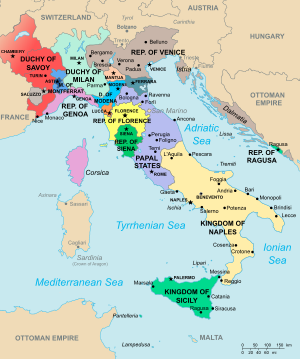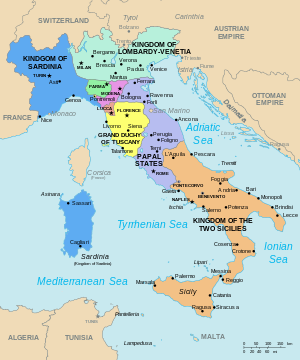Cesi family
| Cesi | |
|---|---|
 | |
| Country | |
| Current region | |
| Place of origin | Cesi, Terni |
| Founded | XIV century |
| Founder | Pietro Chitani da Cesi |
| Titles |
|
| Connected families | Caetani, D'altemps, Della Rovere, Orsini, Colonna, Salviati, Lante, Sforza |
| Motto | Omnibus Idem |
| Estate(s) |
|
| Dissolution | XIX century |
| Cadet branches | Cittadini-Cesi |
The Cesi family is an Italian noble family from Umbria.[1]
Origins

The Cesi family takes its surname from Cesi. The fieldom of Cesi was originally part of the Lombard Duchy of Spoleto. The Cesi fief was of the Arnolfi family, the chief seat of the Terre Arnolfe.[2] The Arnolfi family claimed descent from the Lombard Arnulf, vassal of Duke of Spoleto. The duchy was then annexed to the Papal States.[3] It comes from the Latin word caesi and the Latin verb caedere. Contraction of the Lombard toponym Cesina, which indicated a coppice wood or a place cleared of woodland.
History
According to the "Relation de Rome" of the French Ambassador to the court of Urban VIII, Amayden, the Cesi family was located in Umbria (with its main seat the castle of Cesi). Antonio Chitani of Cesi, the chief of the family, and his wife Angela Ternabili were slaughtered in the Church of St. Anthony Abbot, in the castle of Cesi, on the feast day of the saint, with all their relatives.[4] Only their son Pietro (1422-1477) , still in swaddling clothes, escaped the massacre.[4] Pietro moved to Rome and later became a very famous consistory lawyer to the point of obtaining the office of podestà of Perugia first and then that of senator in Rome.[4] The three sons born to Pietro, Bartolomeo, Pierdonato, and Angelo, respectively, originated three branches of the family.[4]
The last of Pietro's sons, Angelo or Agnolo, married Franceschina Cardoli, a descendant on his mother's side of the famous condottiero Gattamelata; he himself was a very distinguished personage of his time, becoming a jurisconsult, professor of the Roman Archiginnassio, consistorial lawyer and senator like his father until he was noticed by Pope Julius II, who appointed him first apostolic secretary and then auditor of the apostolic chamber.[4] He was also a splendid patron, commissioning Michelangelo to build the family chapel in the church of Santa Maria della Pace in Rome.[4] His son, Maximilian Octavius, was bishop of Cervia, while two of his other sons, Federico and Paolo Emilio, were both cardinals.[5]
Giangiacomo, Angelo's son, was decemvir at Todi and was noble of Terni. He took part in the siege of Florence in 1530, also distinguishing himself as a condottiero. Through his wife, Isabella Liviani d'Alviano, who bequeathed him his father's fiefdom, he was able to make an exchange with Pierluigi Farnese, receiving in exchange the fiefs of Acquasparta and Portaria.
Giangiacomo's son, Angelo, followed in his father's footsteps and was also a decemvir at Todi and a nobleman at Terni, embarking like his parent on a military career on behalf of the Church State.[4] In 1569, during the reign of Pius V, he commanded a military expeditionary force in France to bring aid to Charles IX against the Huguenots.[4] He distinguished himself in the capture of Poitiers where he later died in 1570.[4] He had a palace in Rome in via della Maschera d'oro that later became the seat of his household and erected a grand mausoleum to his uncle, Cardinal Federico Cesi, in the church of Santa Maria Maggiore.[4]
His sons were Bartolomeo, who later became archbishop of Conza, bishop of Tivoli and cardinal, and Federico, who first assumed the title of marquis of Monticelli.[5] In favor of the latter, Pope Sixtus V erected the fiefdom of Acquasparta into a duchy in 1588, while Pope Paul V in 1613 granted him the principality over the marquisates of San Polo dei Cavalieri and Sant'Angelo. The latter married Princess Olimpia Orsini.
Federico (1562-1630), was the eldest son of the former and 2nd Duke of Acquasparta. His brother Firmino, became bishop of Rimini. His son, founder of the Accademia dei Lincei, would be known as Federico the Lyncean and would be one of the greatest scholars of the 17th century. He married Princess Artemisia Colonna in first marriage and Marchesa Isabella Salviati in second marriage.
The family grew and prospered until the second half of the 17th century when it sold most of its property to the Borghese family. At this point the branch of the dukes of Acquasparta was succeeded by the one originated by Bartolomeo with Giacomo di Giuseppe who in 1804 and then with his son, Luigi in 1821.
The Pierdonato branch ruled with the title of marquis and duke in several fiefs in the Sabina area, dying out in 1657 with the death of Francesco Maria Cesi, duke of Ceri and Selci, titles that returned to the main branch of the lineage.
Family tree
Notable members
Cesi cardinals
- Paolo Emilio Cesi (1481–1537)[6]
- Federico Cesi (1500–1565), younger brother of Cardinal Paolo Emilio Cesi.
- Pier Donato Cesi (1521–1586), seniore (senior)
- Pier Donato Cesi (1583–1656), iuniore (junior)
- Bartolomeo Cesi (1566–1621)
Cesi bishops
- Bartolomeo Cesi (died 1537), Bishop of Narni until his death in 1537.
Cesi nobles
Princes of San Polo and Sant'Angelo (1613-1670), Dukes of Acquasparta and Marquesses of Monticelli (1588)
- Federico I Cesi (1562–1630), I prince of San Polo and Sant'Angelo, I duke of Acquasparta, I marquis of Monticelli.
- Federico II Cesi (1585-1630), II prince of San Polo and Sant'Angelo, II duke of Acquasparta, II marquis of Monticelli, scientist, naturalist and founder of the Accademia dei Lincei.[7]
- Giovanni Cesi (died 1656), III prince of San Polo and Sant'Angelo, III duke of Acquasparta, III marquis of Monticelli.
- Federico III Cesi (died 1666), IV prince of San Polo and Sant'Angelo, IV duke of Acquasparta, IV marquis of Monticelli
- Giuseppe Angelo Cesi (died 1705), V prince of San Polo and Sant'Angelo, V duke of Acquasparta, V marquis of Monticelli.
The fiefdom of San Polo and Sant'Angelo is sold with the relative title to the Borghese princes; the other titles of duke and marquis remain active.
- Federico IV Pierdonato Cesi (died 1762), VI duke of Acquasparta, VI marquis of Monticelli.
- Carlo Federico Cesi (died 1774), VII duke of Acquasparta, VII marquis of Monticelli.
- Federico V Cesi (1766–1799), VIII duke of Acquasparta, VIII marquis of Monticelli.
- Giacomo Cesi (died 1821), IX duke of Acquasparta, IX marquis of Monticelli.
- Luigi Cesi, X duke of Acquasparta, X marquis of Monticelli.
- Federico VI Cesi, XI duke of Acquasparta, XI marquis of Monticelli.
- Gerberto, XII duke of Acquasparta, XII marquis of Monticelli.
- Elvira, duchess of Acquasparta, married Marquis Gaspare Cittadini and gave rise to the Cittadini-Cesi lineage.
Dukes of Selci (1596) and of Ceri (c. 1612)
- Paolo Emilio Cesi (d. 1611), II duke of Selci (title acquired from the Orsini)
- Andrea Cesi (d. 1626), I duke of Ceri, III duke of Selci
- Francesco Maria Cesi (d. 1657), II duke of Ceri, IV duke of Selci
Upon his death, the title of Duke of Selci passed to the main family branch, while that of Duke of Ceri passed to the Borromeo family.
References
- ^ "Cèsi". treccani.it. treccani.it. Retrieved 8 September 2022.
- ^ "ARNOLFE, TERRE". treccani.it. treccani.it. Retrieved 8 September 2022.
- ^ "PATRIMONIUM SANCTI PETRI". treccani.it. treccani.it. Retrieved 8 September 2022.
- ^ a b c d e f g h i j "La famiglia Cesi". difesa.it (in Italian).
- ^ a b Garollo (1907), p. 509
- ^ "CESI, Paolo Emilio". treccani.it. treccani.it. Retrieved 8 September 2022.
- ^ "Cèsi, Federico, detto il Linceo". treccani.it. treccani.it. Retrieved 8 September 2022.
Bibliography
- Theodore Amayden (c. 1620). Relation de Rome (in French).
- Gottardo Garollo (1907). Dizionario biografico universale (in Italian). Vol. 1. Milano: Ulrico Hoepli.


